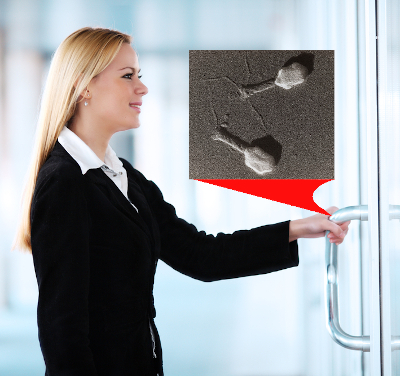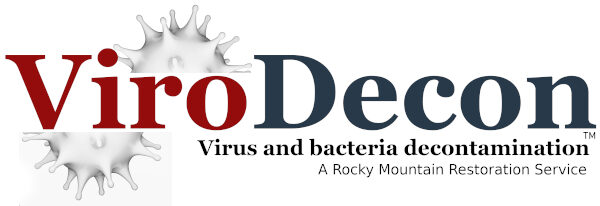Many people ask: how long will a virus live on a surface? The question is relevant for the question of whether one needs to decontaminate after a known exposure.
There are conflicting studies on the subject but some studies show most cold and flu viruses live a few hours outside the body while others show that the typical flu virus survives at least 24 hours. COVID-19 lasts longer with estimates saying 72 hours to 6 days.
Hard surfaces:

Viruses live a bit longer on hard surfaces than soft surfaces. Hard surfaces are very effective at transmitting viruses person to person and an area of concern.
- Office desks
- Walls
- Doors and door handles
- Bathroom sinks and toilets
- Toys
- Railings
- Kitchen counters, knobs
- Tools frequently used
For example the new Coronavirus COVID-19 is spread through moisture droplets sneezed or expelled by the infected person which are either directly breathed in through a person’s nose within 6 feet, or more commonly land on objects close to the person. Doorknobs, desks, tray tables are likely transmission objects. COVID-19 is not a virus that is airborne like measles, it requires being encased in a tiny moisture droplet.
Bacteria, unlike viruses can live longer on hard surfaces. Staphylococcus aureus (linked to sinusitis, skin infections, food poisoning) can survive for months. Monthly disinfection services by ViroDecon are designed to stop these kinds of persistent bugs in places like medical offices and food service.
Solution: Disinfection sprays/misting are common for hard surfaces. Many solutions like bleach corrode or stain materials. Disinfection often does not kill toxic mold spores, a different solution is used for mold. Some viruses are more hard to kill and so many common disinfectants won’t work.
Soft textured surfaces:
Bacteria have been found to live up to three months on common fabrics used in hospitals: curtains, bed sheets, upholstery. (polyester and cotton)
Washing fabrics – even after laundering fabrics can have infectious particles, still laundering curtains and any fabric that could be laundered is recommended on a regular basis. Most hospitals overlooked upholstery and curtains in their regular cleaning process.

Solution: We use EPA registered spray solutions on many soft surfaces as well as UV lighting systems designed to kill bacteria and viruses. Our technology >
Temperature:
- Hot temps: viruses can certainly spread during hot weather months despite what some uneducated sources say.
- Cooking food properly at 70 C or above usually kills viruses. Outbreaks of Norovirus were linked to eating raw shellfish like oysters. In restaurants food preparers could easily spread the virus to kitchen surfaces before cooking the meal so the virus was actively contaminating other surfaces.
- Autoclaving (using steam to sterilize) is very common and used for disinfection in hospitals.
- Cold temps:
- The Avian Flu H5N1 virus could survive up to a month while in frozen or refrigerated birds. Cooking chicken at over 70 C did kill the virus.
- Many viruses are locked in frozen lakes and glaciers and may be released as global temperatures rise, but it depends on how they were frozen. If they froze and thawed many times it will likely have destroyed the structure. The thawing process kills 90% of viruses. If a virus was frozen only once and stayed frozen it could be intact. Most frozen viruses that pose a threat come from bird droppings.
Humidity:
Higher humidity indoors shortens the life of viruses.
According to some studies keeping a home humidified at 40-60% humidity is likely to reduce the life of viruses living on surfaces throughout the home however humidifiers are just as likely to spread the flu and mold spores.
In colder climates the flu thrives when its cold and dry as the virus survives longer outside the body. However in the tropics the flu peaks when it’s hot and rainy. This phenomena is still being studied.
BACK: Virus vs. Bacteria, what is the difference?
Source:
Mayoclinic
https://www.mayoclinic.org/diseases-conditions/flu/expert-answers/infectious-disease/faq-20057907
WHO
https://www.who.int/influenza/resources/documents/food_risk_h5n1_11_2005/en/
Food Safety Experts
https://www.foodsafety-experts.com/food-safety/norovirus/
The Dangers of Pathogens on Soft Surfaces
https://www.infectioncontroltoday.com/environmental-hygiene/new-frontier-dangers-pathogens-soft-surfaces
Best Practices for Soft Surface Decontamination
https://www.beckershospitalreview.com/quality/best-practices-for-soft-surface-decontamination-q-a-with-clorox-s-dr-kelly-a-reynolds.html
How Weather Sparks the Flu
https://www.npr.org/sections/health-shots/2013/03/08/173816815/flu-risk-and-weather-its-not-the-heat-its-the-humidity
Harvard.edu
http://sitn.hms.harvard.edu/flash/2014/the-reason-for-the-season-why-flu-strikes-in-winter/
Frozen viruses
https://www.newscientist.com/article/dn10676-can-flu-viruses-survive-winter-in-frozen-lakes/
